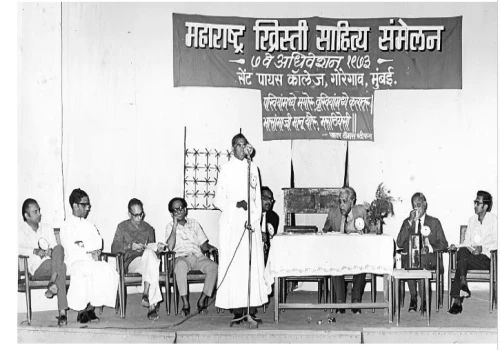
The presence of Islam in society as a settled and unchangeable fact
“Every blessing is a curse; every curse is a blessing.”
For a long while, under the misguided influence of a very unhappy woman who had converted to Islam for all the wrong reasons, I was under the impression that the source of the commonplace, “Every blessing is a curse, every curse is a blessing," was the Hadith. The saying is actually a 20th-century commonplace that sounds like it came from an older tradition in terms of its rhetorical balance and epigrammatic style.
And as the sad lady who often resorted to the expression, the sad history of the last millennium and a half is equally the result of a sequence of misunderstandings, both cursed and blessed. At times, deliberate misinterpretations of the respective sacred scriptures presumably proclaimed by the various proponents of the so-called “word of God” has led to violence and the loss of millions of lives on the one hand, and great cultural, linguistic, artistic and technical advances on the other. During the worst of these periods of intense reaction and exalted creativity, our common history serves as a testament that to whoever or whatever it is, Satan is not only real but a force lying in wait to tempt those who seek unity with the Godhead only to end up serving the forces of evil. To comprehend how humanity reached this critical juncture, we must first comprehend the historical events that paved the path from good intentions to hell, and how each event successfully triggered the next.
After the destruction of the Second Temple in Jerusalem, ancient Jewish tradition was preempted by various sects competing for ethnographic and geopolitical dominance in ancient Palestine. Among those who rejected the divinity of Christ as the long-awaited Messiah, the rabbinical schools arose to finalize the break with Messianic Jews. All and any who accepted Jesus’ teachings were cast out of the synagogue, openly condemned as heretics, and fiercely persecuted with the help of the occupying Roman government. From this period on, we can trace the evolution of the Talmud, which was intended to interpret the Mosaic law, or Torah, yet managed to include the most hateful and diabolic texts to indicate Rabbinic Judaism's fear, rejection, and detestation of Christians and Christian doctrine.
Within less than thirty years of the Crucifixion, the martyrdom of St. James, first bishop of Jerusalem, was just one of thousands of cases in which the rabbinical party documented its fear of the threat posed to its control of the Jewish people by the early church. In his controversial analysis of Christ's resurrection, Rabbi Pinchas Lapide recently demonstrated the depth of the Jewish priests' fear: if the temple priests had been able to obtain and point to Christ's dead body to refute the apostles' testimony, they could have effectively shut down the new sect. Their failure to do so under the strict guard of Roman soldiers posted at the tomb underscores their impotence. Rabbi Lapide elaborates on this fact, demonstrating that Christ's resurrection from the dead was genuine for both non-believers and believers. Such historical documentation indicates that the Jewish communities in Alexandria, Athens, Ephesus, Galatia, Antioch, and Rome saw their numbers increase significantly beyond those of the resistant rabbinically controlled Jewish population in ancient Palestine. It would appear, then, that the split was far greater than the remnant Jewish population. The Jewish Christians who recognized Jesus as the Messiah observed Jewish law. However, as those Jewish Christian communities added to their number increasingly with the conversion of uncircumcised Greeks, Syrians, and Africans, the rabbinic schools demanded their complete expulsion from the synagogues. This led to the early Jewish Nazarenes’ exiting the synagogue due to their refusal to recite rabbinical prayers which specifically condemned Jesus as a false messiah. Within another three decades, the threat posed by the early church to rabbinic Judaism became even greater. And it did so at the cost of separating Christianity from Mosaic, not Rabbinic, Judaism in the most detrimental way possible.
Christianity no sooner ceased to be a threat to rabbinic Judaism than it became a real threat to the Roman Empire. Only until Flavius Josephus, a Jewish military leader employed by Rome under the new Flavian dynasty, did hostilities between both camps escalate to a critical juncture. Josephus admitted the historical presence of Jesus Christ while agitating for the Rabbinical party’s acceptance of Roman domination. In short, he worked only to assist the empire and its first Flavian emperor, Vespasian, in removing the threat posed by the early Christians. With the accession of Titus as emperor, however, the fate of both parties, the Rabbinical and the Jewish Christians with their vastly growing Gentile population, was sealed. The Second Temple was destroyed which initiated the diaspora of the Jews and the intensification of the persecution of the Christians throughout the Roman Empire.
Indeed, the short-lived blessing sought by the Rabbinical party only led to the growth of Christianity. The Romans regarded Christianity, and not Rabbinical Judaism, after all, as the greatest political threat to their global imperium. The only means they attempted to enforce obedience to Roman rule was by guaranteeing the worship of Roman gods. Out of Flavius Josephus’ histories, unfortunately, arose the only logical construct to divide what was in fact two different branches by the early Christians. Flavius’ bias led to the only logical construct for the early church, an intense antipathy for all things Jewish, even so far as denying their Jewish roots. The sad result of this credal hatred inadvertently gave rise to the eventual persecution of all Jews within another century and a half. Emperor Constantine made Christianity the state religion at the dawn of the fourth century. And once the newly recognized church assumed dogmatic power, it set out to persecute all those who slaughtered and persecuted it during the first three centuries, namely the pagans and the Jews.
An unfortunate historical phase of this demonically inspired madness persisted during and continued after the rise of Protestantism, which gave birth to the anti-Semitic hatred embodied by Nazism. History is ironic so long as viewed from the comfortable though relative safety afforded by the passing of centuries. For the innocent Jews, whose only crime was to be regarded as practitioners of Talmudic hatred, were hounded and slaughtered in Western Christendom under the fierce prescriptions of the papacy, which regarded itself as the real authority behind the new imperial rulers, the Western Holy Roman Empire and the Byzantine Empire, until their machinations finally led to the collapse of Byzantium.
Purely from the viewpoint of a social historian, we can already begin to see the historical phenomenon taking shape that would set in motion the development of the world, not just Western civilization, for the next fifteen hundred years. Just as the older sect sought to repress the newer with harsh censure, martyrdom, and political advantage, it resulted only in assuring the eventual spread of whatever newer doctrinal position was coming into historical being. And each doctrinal position always centered on the identity of Jesus Christ. More importantly, from the perspective of this essay, understanding this pattern is crucial for interpreting the later acceptance of Old and New Testament teachings in the scriptures of Islam. This phenomenon held sway especially when Muhammad announced his fulfillment of the prophetic vision, from Abraham through Christ. Mohammed’s insistence on Jesus’ role as a prophet of Islam could have served as a miraculous bridge between all these competing visions in a perfect world. Unfortunately, the leaders of these disparate nations and cultures fell victim to their inner demons and chose to avoid practicing what they preached.
The archetypal evidence, however, remains to this day the most intriguing aspect of the history of these three religious groups. And it is to be found in the Old Testament, the source of all three doctrines; we find it in the historical revelation where, according to Jews and Christians, Abraham rejected his firstborn, Ishmael, as his heir in favor of the younger brother, Isaac. From the Islamic perspective, it is Ishmael who becomes the chosen heir destined to carry out the divine plan and bring all humanity to the one true God. On the basis of symbolism and historical reality alone, however, we can see that these critical choices leading to rejection also proved critical for the isolation of Judaism according to the strict tenets of rabbinical teachings seeking to cast out anyone not born of a Jewish mother.
Later on, we see it, though less absolute than the demands of ethnic purity, among Christians who base their raison d’être upon the doctrine of Christ’s death and resurrection. The evolution of Christian doctrine is, of course, meant to combat the early heresies that sought to equate Jesus Christ as just another holy man who somehow provided insight into the nature of God. Like the earlier contention against rabbinic Judaism, though less divisive after the appearance of Islam, this might have led to a more tolerant view of the new sect, which embraced Christ’s resurrection and ascension but rejected his Triune divinity. And this too was caused by Muhammed’s encounter with Christian heretics.
The prophet Muhammad’s only exposure to Christianity was through the influence of apocalyptically obsessed Arian heretic priests who saw Muhammad as the second coming of Jesus Christ and one who would finally precipitate the Messianic Age. Thus Christianity’s unfortunate rejection of early Islam as just another Arian heresy instead of some inspired witness to the overall validity of the divine presence was predicated at the outset. The catastrophic result of this error, choosing enmity over the eventual possibility of unity, is finally realized in the Roman pontiffs’ loss of Constantinople to Islam in a way that assured the rise of the greatest threat to Christianity, and later Islam itself, the Turkish empire.
Dante’s harsh view of Muhammed and the Roman papacy is the most curious of the historical evidence, which had access to a more accepting view of the new creed’s scientific and philosophical advances yet refused to tolerate it for its benefits while completely attempting to exterminate and deracinate it in its native soil. This repetition of past obstinacy only serves to remind us of ancient Jews’ refusal to hear the greatest of the Pharisees, Gamaliel’s plea for tolerance. This sainted rabbi’s judgment of Christianity as either a falsehood or a new revelation by God was underscored in his advice to cease persecution and wait for divine judgment. “ If this belief is not from God, it will surely fade away.”
Dante, the indefatigable warrior for Christian doctrine even against heretical popes, was mindful of the great philosophical gifts that Islam had presented to the Christian Schoolmen. The hounded professor at Paris, Siger of Brabant, was the earliest proponent of the Islamic theories of Avicenna and Averroes. The Turkish sultanate excommunicated Siger and later condemned his Muslim teachers as heretics. For it was their use of Augustinian theology that helped shape the evolution of philosophy as a separate body of knowledge from theology. And without this perspective, the greatest Catholic philosopher, Thomas Aquinas, would never have progressed in applying Aristotelian logic to Christian doctrine. Yet Dante placed Muhammed in the Inferno and Siger in the Paradiso, while rejecting the degenerated papacy in favor of the authority of the Byzantine church and emperors. Perhaps the greatest minds, unlike the rest of mankind, should have fought more for tolerance and understanding based on their own discovery of true wisdom within their respective historical contexts. It is not too late for honest Jews, Christians, and Muslims today, however, to see beyond their differences and remain open to any available divine wisdom for better understanding and ecumenical advancement.
The Quran insists upon the nature of Jesus as both the Messiah and the Son of God, though unbeknownst to most Christians and Jews alike.. Instead, the harsher and more
The Orthodox Christian Church consistently responds aggressively by rejecting Islam as a demonic cult. The eventual rejection of Muhammad’s teachings only managed to turn Islam into a competing religion instead. The historical contradiction can be seen in the history of the Third Crusade where Europeans are returning to Jerusalem to secure the holy sites of Christianity as well as keep Sunni Muslims from slaughtering Shia Muslims Such a view is incoherent unless they regarded the followers of Muhammed as heretics rather than some distinct group of believers. The Crusades were a time when both Christians and Muslims revered Mary, the Mother of Christ, as a saint and witness to God's active role in human affairs. In this regard, Islam to this day has proven itself more faithful to the teachings of Christian doctrine in their veneration of Christ and the saints than most self-contradictory sects of low church Protestantism. However, there is no violent rejection of the errors of low church Protestantism, such as the denial of the communion of saints and the validity of the Blessed Sacrament, unlike Muhammad’s followers who also deny the Blessed Sacrament, which was instituted by Christ in the very testament they claim to honor. This disparity can only be due to cultural rather than doctrinal differences if not outright bigotry and blind prejudice.
So it is against this historical evidence of the enmity among the three groups who claim to be sons of the one true God that we can understand how the current world of violence and barbarism against all and any who follow a competing version of the same truth came about. In point of fact, Muhammed sought to bring his people of the Arabian Peninsula to the worship of God while actually settling the Christological dispute between Judaism and Christianity. Yes, the irony of the prophet as a peacemaker after his divine vision. Later, when the Jews of the Arabian Peninsula rejected his teachings, the prophet turned upon them with equal force and sought to expunge all and any who would not “accept the word of God.” This shift can be seen in the evolution of the Quran, as the surahs of the Meccan period contrast their teachings of purely doctrinal and theological wisdom with the later legalistic Medinese surahs that insist upon the requirement for purity only through ridding the world of all non-believers, especially obstinate Jews and idolatrous Christians alike.
While the history of past atrocities cannot be erased through wishful thinking, the possibility of future efforts to guarantee peace and tolerance among the three religions can and should be pursued. In it lies the very nature of civilization’s survival. The only viable path forward is for responsible religious leaders from all three religions to advocate for unity among their followers in adhering to the fundamental religious tenets that ensure civilization's survival. Murder for the sake of some diabolically inspired adherence to a respective cult must be denounced universally.
To make it more palpably effective among these various adherents, they must first educate their followers by instructing them that this diabolical drive is always and everywhere traceable to the demonic plans of their globalist masters. When they commit such crimes against one another, the only beneficiaries are the globalist criminals who benefit from social and cultural anarchy and genocide. As throughout the history of the last three centuries, during which over a billion innocents were slaughtered under the globalist influence, all these evil roads lead directly to the House of Rothschild and its various international crime subsidiaries. Their roll call of satanic hierarchy must be made known and can be with our persistence to remain united in their constant denunciation. These crimes syndicates continue to exist as their British puppets, known as the “royal” family; their American enforcers, known as the Bush Crime Family, their Chinese/North Korean puppets, aka the Communist Party; their chief tyrannical representatives in the Baltic, aka Zelensky and Putin; their Wahhabist enforcers, aka the House of Saud, their Afghan suppliers for all their drug cartels from Mexico to Marseille; their radical representatives on the Indian subcontinent; the atomically enhanced rulers of Pakistan; and, last but not least dangerous of all, their new Persian Caliphate, the Iranian Mullahs. Yes, world leaders who oversee this scourge against humanity serve the Rothschilds.
The longer these satanic forces remain united despite their deliberate disguise of competitive mischief, the longer the followers of so-called divine obedience will remain divided only to suffer under their globalist masters’ anarchic reign of terror. Unless people are educated regarding the identity of their real satanic enemies, do not expect anything to change.












